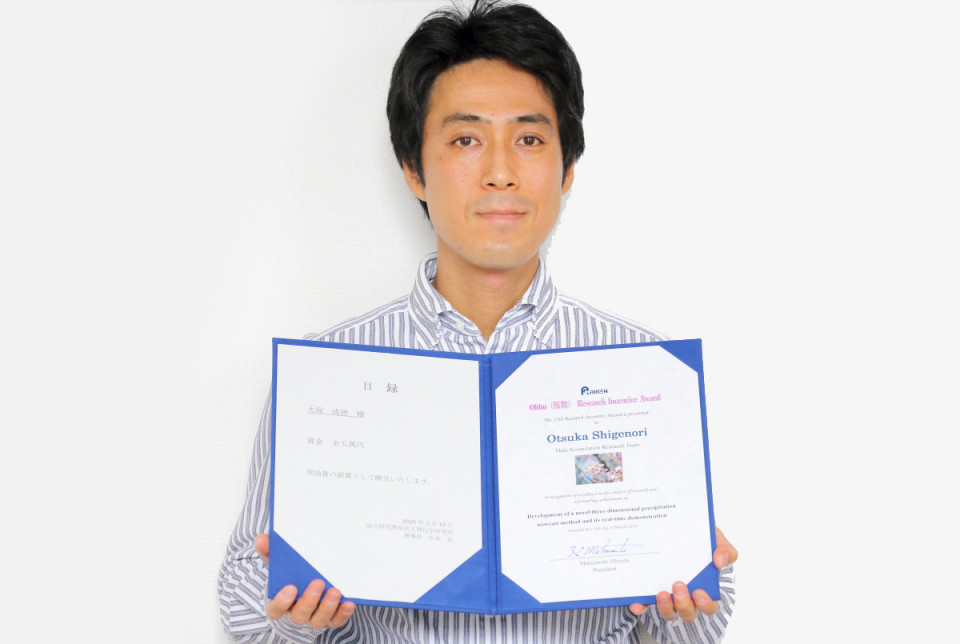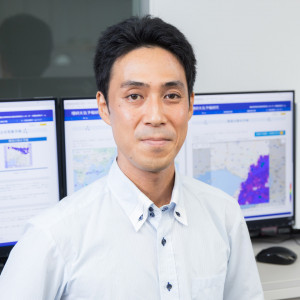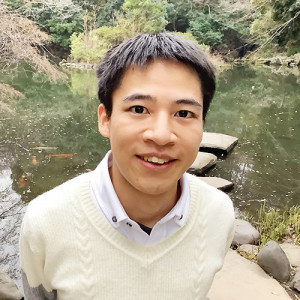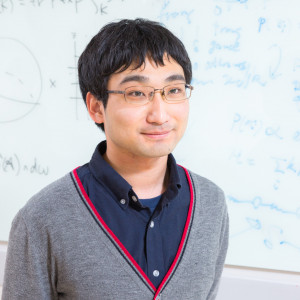Volume 105
Back to Newsletter List
Award
Dr. Shigenori Otsuka received 11th annual RIKEN Research Incentive Award (Ohbu Award)
2020-05-28
Shigenori Otsuka received "FY2019 Researcher Incentive Award (桜舞賞)" on March 10, 2020 for his achievements in the "Development of a novel three-dimensional precipitation nowcast method and its real-time demonstration". Congratulations!
Seminar Report
QFT-core Seminar “Gradient Flow Equation and Its Applications” on May 15, 2020
2020-05-25
The QFT-core seminar series has been started from this fiscal year. The seminar series is hold under the theme of the Quantum Field Theory including elementary particle theory, nuclear theory and Condensed Matter physics.
The First seminar in the series was given by Dr.Kengo Kikuchi from the Riken iTHEMS on May 15. The title is “Gradient Flow Equation and Its Applications”. The gradient flow is the one of the methods to suppress the ultraviolet divergence in gauge theories. The any correlation functions in terms of the flowed field, which is defined by the gradient flow equation, are finite without additional renormalizations. Because of this surprising property, the methods has been studied widely, especially in the lattice field theory. In this seminar, he introduce what the gradient flow is briefly, and show his work, “generalized gradient flow equation”, which is the gradient flow equation for field theories with nonlinearly realized symmetry. Applying the formalism to a supersymmetric theory and O(N) non linear sigma model, the SUSY gradient flow and the Large N gradient flow are obtained. He also refer to the current research, the gradient flow of the supersymmetric theory with the non-renormalization theorem and the new formalism to obtain the sphalerons, which is one of the static classical solutions, using gradient flow methods.
The seminar was hold via Zoom. There were about 20 participants from iTHEMS and other university. The participants enjoyed meaningful discussions through the seminar.
Gradient Flow Equation and Its Applications
May 15 (Fri) 13:30 - 15:00, 2020
Seminar Report
Math Seminar by Dr. Yukimi Goto
2020-05-15
Math seminar titled "How many electrons can atoms bind?" by Dr. Yukimi Goto was hold on 13 May. In the first part, the speaker started the talk by introducing many body Hamiltonian and Pauli principle. She then introduced the ionization conjecture. She also introduced some known results concerning about this conjecture. In the second part, the speaker introduced approximation methods and its relation to the ionization conjecture. She first introduced Thomas-Fermi theory and see TF functional appears as a leading term of grand state energy for large atom. She introduced Hartree-Fock theory next. She mentioned a variant of the ionization conjecture for HF theory was proven by Solovej, but original conjecture is still open. She then explained HF theory can be regarded as good approximation in terms of volume.
How many electrons can atoms bind?
May 13 (Wed) 16:00 - 18:10, 2020
Upcoming Events
Seminar
QFT-core Seminar
Localization and universality in non-Hermitian many-body systems
May 29 (Fri) 15:00 - 16:30, 2020
Ryusuke Hamazaki (Senior Research Scientist, RIKEN Interdisciplinary Theoretical and Mathematical Sciences Program (iTHEMS) / RIKEN Hakubi Team Leader, Nonequilibrium Quantum Statistical Mechanics RIKEN Hakubi Research Team, RIKEN Cluster for Pioneering Research (CPR))
Recent study on isolated quantum many-body systems have revealed two different phases distinguished by their dynamics and spectral statistics. One is an ergodic phase whose spectral statistics exhibit universality of random matrices, and the other is a many-body localized phase where dynamics is constrained due to strong disorder. In this talk, we show that novel and rich physics concerning such localization and universality appears in non-Hermitian many-body systems, which have been utilized in diverse scientific disciplines from open quantum systems to biology.
As a first topic, we analyze non-Hermitian quantum many-body systems in the presence of interaction and disorder [1]. We demonstrate that a novel real-complex transition occurs upon many-body localization of non-Hermitian interacting systems with asymmetric hopping that respect time-reversal symmetry. As a second topic, we show that “Dyson’s threefold way,” a threefold symmetry classification of universal spectral statistics of random matrices, is nontrivially extended to non-Hermitian random matrices [2]. We report our discovery of two distinct universality classes characterized by transposition symmetry, which is distinct from time-reversal symmetry due to non-Hermiticity. We show that the newly found universality classes indeed manifest themselves in dissipative quantum many-body ergodic systems described by Lindblad equations.
References
- RH, K. Kawabata, and M. Ueda, Phys. Rev. Lett. 123, 090603 (2019)
- RH, K. Kawabata, N. Kura and M. Ueda, Phys. Rev. Research, to appear (2020)
Venue: via Zoom
Event Official Language: English
Seminar
iTHEMS Biology Seminar
Quantification model of energy of loop structure on biopolymer
June 3 (Wed) 10:00 - 10:45, 2020
Hiroshi Yokota (Postdoctoral Researcher, RIKEN Interdisciplinary Theoretical and Mathematical Sciences Program (iTHEMS))
During cell division, the chromatin fiber condenses into a rod-like shape, which is the so-called chromosome. The chromosome is constructed by consecutive chromatin loop structures whose excluded volume interaction gives chromosome its stiffness. So far, the energy source for the loop growing has remained a controversial issue. In this seminar, we quantify the energy source by calculating the free energy difference before and after a model polymer chain creating a loop structure.
Venue: via Zoom
Event Official Language: English
Paper of the Week
Week 5 of May
2020-05-28
Title: Revisiting relativistic magnetohydrodynamics from quantum electrodynamics
Author: Masaru Hongo, Koichi Hattori
arXiv: http://arxiv.org/abs/2005.10239v1
Title: Obtaining the sphaleron field configurations with gradient flow
Author: Yu Hamada, Kengo Kikuchi
arXiv: http://arxiv.org/abs/2003.02070v2
Title: The Cayley transform in complex, real and graded K-theory
Author: Chris Bourne, Johannes Kellendonk, Adam Rennie
arXiv: http://arxiv.org/abs/1912.07158v2
Title: Janus interface entropy and Calabi's diastasis in four-dimensional N=2 superconformal field theories
Author: Kanato Goto, Lento Nagano, Tatsuma Nishioka, Takuya Okuda
arXiv: http://arxiv.org/abs/2005.10833v1
Title: Low-Dimensional Fluctuations and Pseudogap in Gaudin-Yang Fermi Gases
Author: Hiroyuki Tajima, Shoichiro Tsutsui, Takahiro M. Doi
arXiv: http://arxiv.org/abs/2005.12124v1
Title: Topologies on schemes and modulus pairs
Author: Bruno Kahn, Hiroyasu Miyazaki
arXiv: http://arxiv.org/abs/1910.14595v2
Title: Goldstino spectrum in an ultracold Bose-Fermi mixture with explicitly broken supersymmetry
Author: Hiroyuki Tajima, Yoshimasa Hidaka, Daisuke Satow
arXiv: http://arxiv.org/abs/2001.08507v2
If you would like to cancel your subscription or change your email address,
please let us know via our contact form.
Copyright © iTHEMS, RIKEN. All rights reserved.









